CHEVROLET CAVALIER 2005 3.G Owners Manual
Manufacturer: CHEVROLET, Model Year: 2005, Model line: CAVALIER, Model: CHEVROLET CAVALIER 2005 3.GPages: 354, PDF Size: 2.19 MB
Page 251 of 354
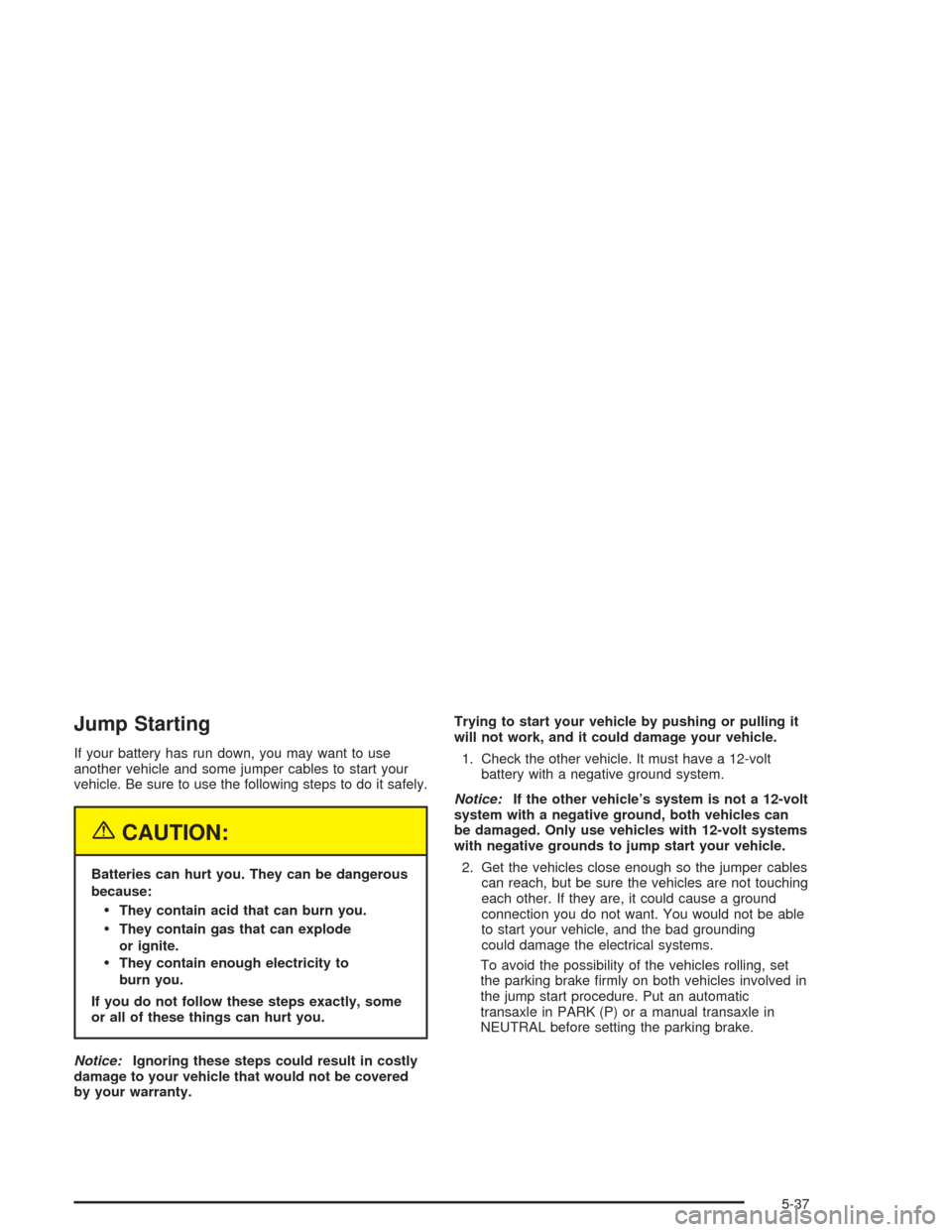
Jump Starting
If your battery has run down, you may want to use
another vehicle and some jumper cables to start your
vehicle. Be sure to use the following steps to do it safely.
{CAUTION:
Batteries can hurt you. They can be dangerous
because:
They contain acid that can burn you.
They contain gas that can explode
or ignite.
They contain enough electricity to
burn you.
If you do not follow these steps exactly, some
or all of these things can hurt you.
Notice:Ignoring these steps could result in costly
damage to your vehicle that would not be covered
by your warranty.Trying to start your vehicle by pushing or pulling it
will not work, and it could damage your vehicle.
1. Check the other vehicle. It must have a 12-volt
battery with a negative ground system.
Notice:If the other vehicle’s system is not a 12-volt
system with a negative ground, both vehicles can
be damaged. Only use vehicles with 12-volt systems
with negative grounds to jump start your vehicle.
2. Get the vehicles close enough so the jumper cables
can reach, but be sure the vehicles are not touching
each other. If they are, it could cause a ground
connection you do not want. You would not be able
to start your vehicle, and the bad grounding
could damage the electrical systems.
To avoid the possibility of the vehicles rolling, set
the parking brake �rmly on both vehicles involved in
the jump start procedure. Put an automatic
transaxle in PARK (P) or a manual transaxle in
NEUTRAL before setting the parking brake.
5-37
Page 252 of 354
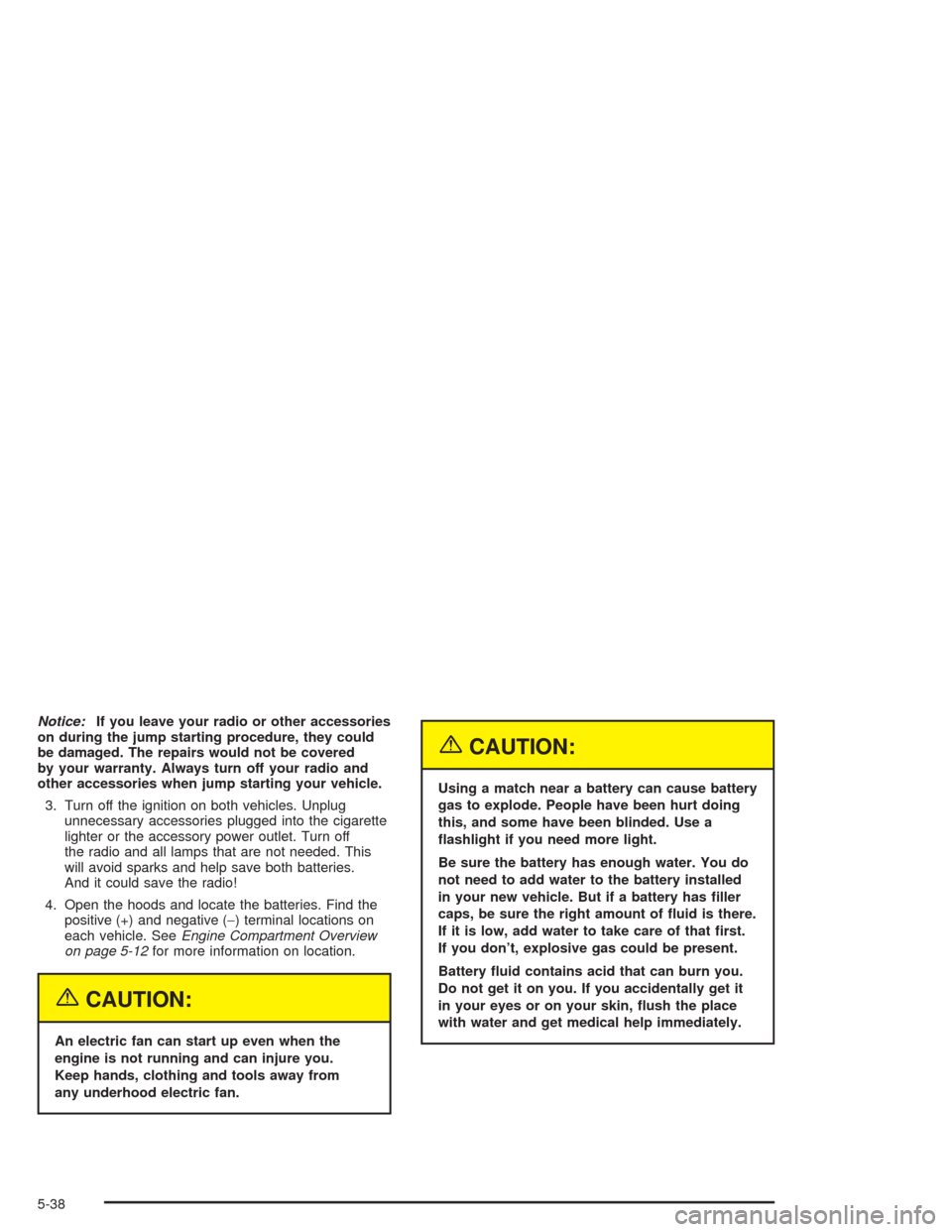
Notice:If you leave your radio or other accessories
on during the jump starting procedure, they could
be damaged. The repairs would not be covered
by your warranty. Always turn off your radio and
other accessories when jump starting your vehicle.
3. Turn off the ignition on both vehicles. Unplug
unnecessary accessories plugged into the cigarette
lighter or the accessory power outlet. Turn off
the radio and all lamps that are not needed. This
will avoid sparks and help save both batteries.
And it could save the radio!
4. Open the hoods and locate the batteries. Find the
positive (+) and negative (−) terminal locations on
each vehicle. SeeEngine Compartment Overview
on page 5-12for more information on location.
{CAUTION:
An electric fan can start up even when the
engine is not running and can injure you.
Keep hands, clothing and tools away from
any underhood electric fan.
{CAUTION:
Using a match near a battery can cause battery
gas to explode. People have been hurt doing
this, and some have been blinded. Use a
�ashlight if you need more light.
Be sure the battery has enough water. You do
not need to add water to the battery installed
in your new vehicle. But if a battery has �ller
caps, be sure the right amount of �uid is there.
If it is low, add water to take care of that �rst.
If you don’t, explosive gas could be present.
Battery �uid contains acid that can burn you.
Do not get it on you. If you accidentally get it
in your eyes or on your skin, �ush the place
with water and get medical help immediately.
5-38
Page 253 of 354
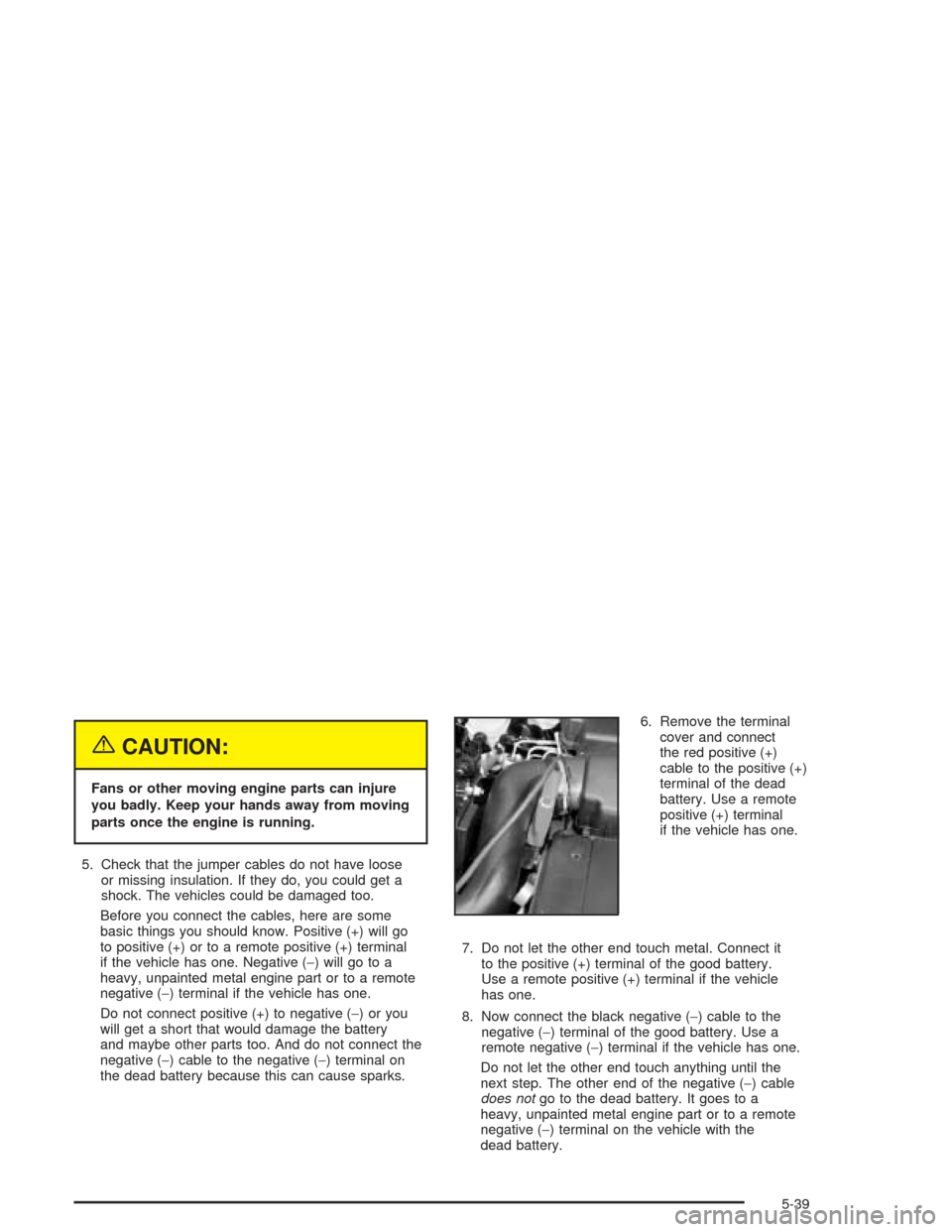
{CAUTION:
Fans or other moving engine parts can injure
you badly. Keep your hands away from moving
parts once the engine is running.
5. Check that the jumper cables do not have loose
or missing insulation. If they do, you could get a
shock. The vehicles could be damaged too.
Before you connect the cables, here are some
basic things you should know. Positive (+) will go
to positive (+) or to a remote positive (+) terminal
if the vehicle has one. Negative (−) will go to a
heavy, unpainted metal engine part or to a remote
negative (−) terminal if the vehicle has one.
Do not connect positive (+) to negative (−)oryou
will get a short that would damage the battery
and maybe other parts too. And do not connect the
negative (−) cable to the negative (−) terminal on
the dead battery because this can cause sparks.6. Remove the terminal
cover and connect
the red positive (+)
cable to the positive (+)
terminal of the dead
battery. Use a remote
positive (+) terminal
if the vehicle has one.
7. Do not let the other end touch metal. Connect it
to the positive (+) terminal of the good battery.
Use a remote positive (+) terminal if the vehicle
has one.
8. Now connect the black negative (−) cable to the
negative (−) terminal of the good battery. Use a
remote negative (−) terminal if the vehicle has one.
Do not let the other end touch anything until the
next step. The other end of the negative (−) cable
does notgo to the dead battery. It goes to a
heavy, unpainted metal engine part or to a remote
negative (−) terminal on the vehicle with the
dead battery.
5-39
Page 254 of 354
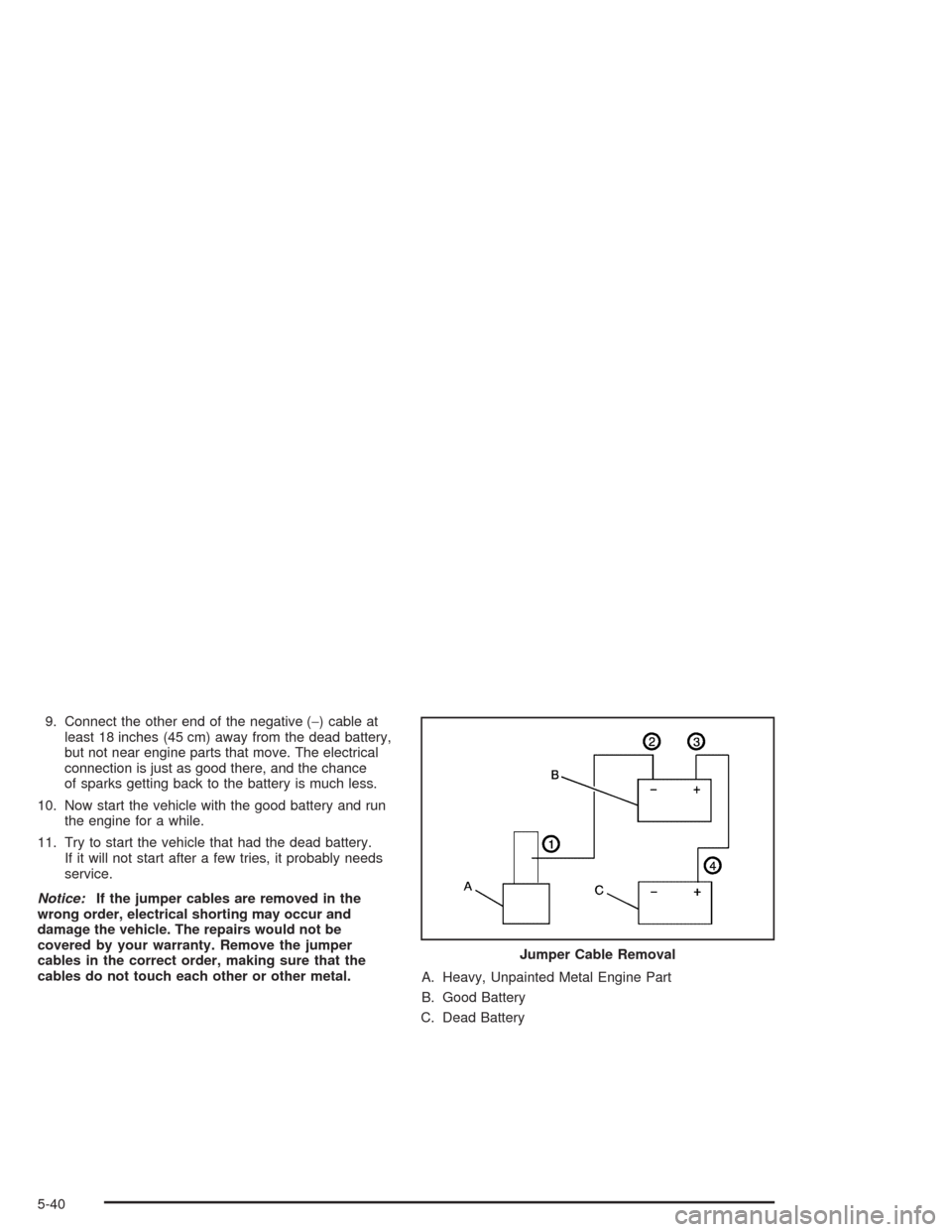
9. Connect the other end of the negative (−) cable at
least 18 inches (45 cm) away from the dead battery,
but not near engine parts that move. The electrical
connection is just as good there, and the chance
of sparks getting back to the battery is much less.
10. Now start the vehicle with the good battery and run
the engine for a while.
11. Try to start the vehicle that had the dead battery.
If it will not start after a few tries, it probably needs
service.
Notice:If the jumper cables are removed in the
wrong order, electrical shorting may occur and
damage the vehicle. The repairs would not be
covered by your warranty. Remove the jumper
cables in the correct order, making sure that the
cables do not touch each other or other metal.
A. Heavy, Unpainted Metal Engine Part
B. Good Battery
C. Dead BatteryJumper Cable Removal
5-40
Page 255 of 354
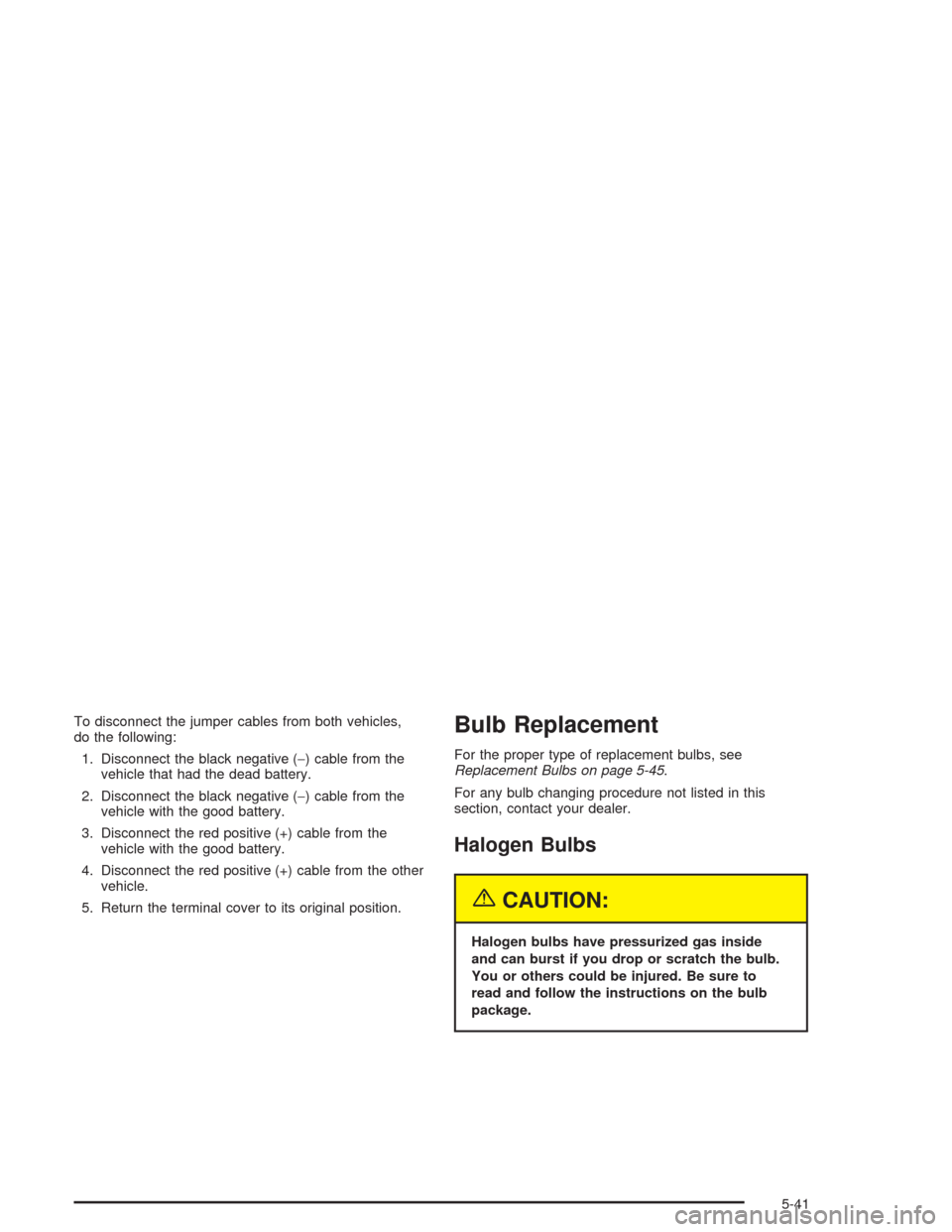
To disconnect the jumper cables from both vehicles,
do the following:
1. Disconnect the black negative (−) cable from the
vehicle that had the dead battery.
2. Disconnect the black negative (−) cable from the
vehicle with the good battery.
3. Disconnect the red positive (+) cable from the
vehicle with the good battery.
4. Disconnect the red positive (+) cable from the other
vehicle.
5. Return the terminal cover to its original position.Bulb Replacement
For the proper type of replacement bulbs, see
Replacement Bulbs on page 5-45.
For any bulb changing procedure not listed in this
section, contact your dealer.
Halogen Bulbs
{CAUTION:
Halogen bulbs have pressurized gas inside
and can burst if you drop or scratch the bulb.
You or others could be injured. Be sure to
read and follow the instructions on the bulb
package.
5-41
Page 256 of 354
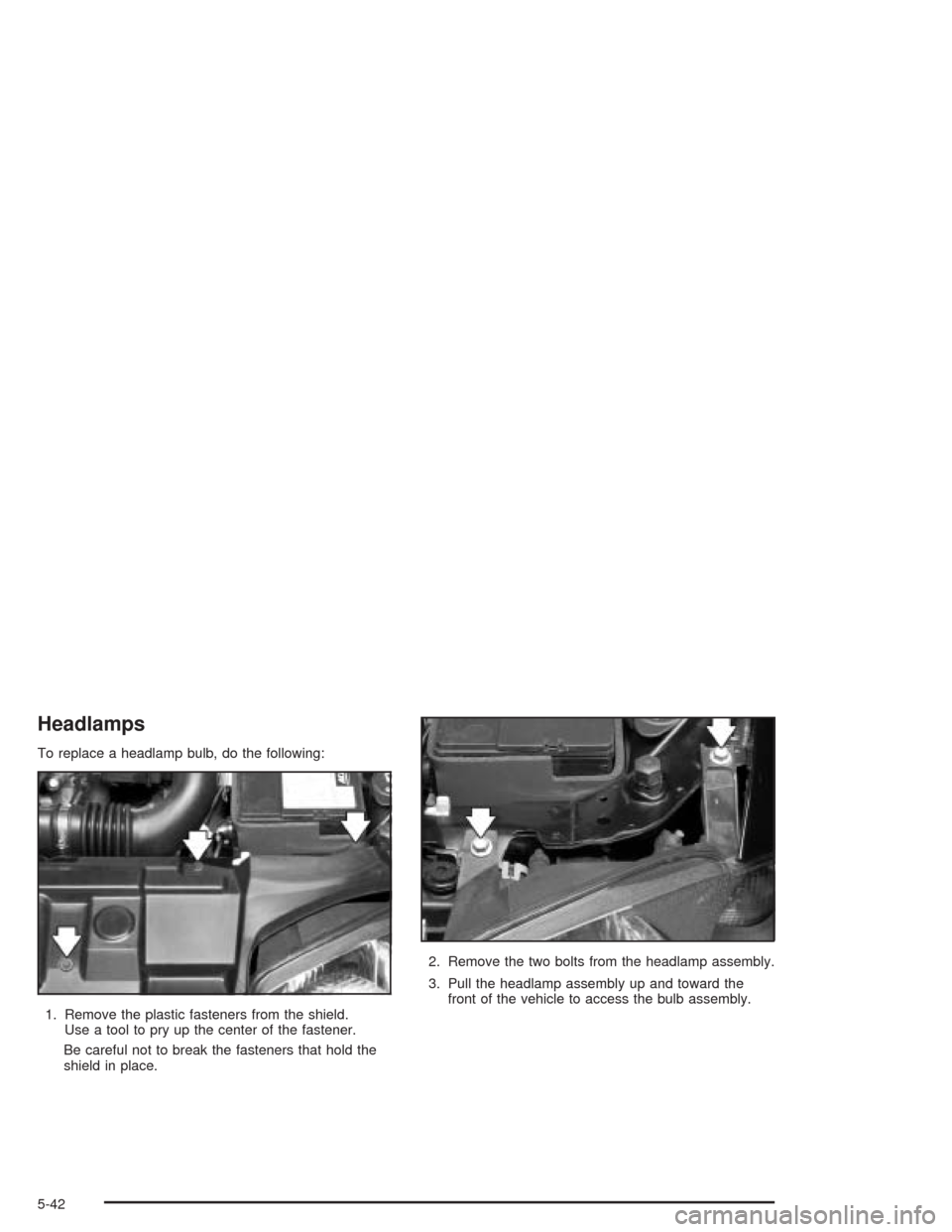
Headlamps
To replace a headlamp bulb, do the following:
1. Remove the plastic fasteners from the shield.
Use a tool to pry up the center of the fastener.
Be careful not to break the fasteners that hold the
shield in place.2. Remove the two bolts from the headlamp assembly.
3. Pull the headlamp assembly up and toward the
front of the vehicle to access the bulb assembly.
5-42
Page 257 of 354
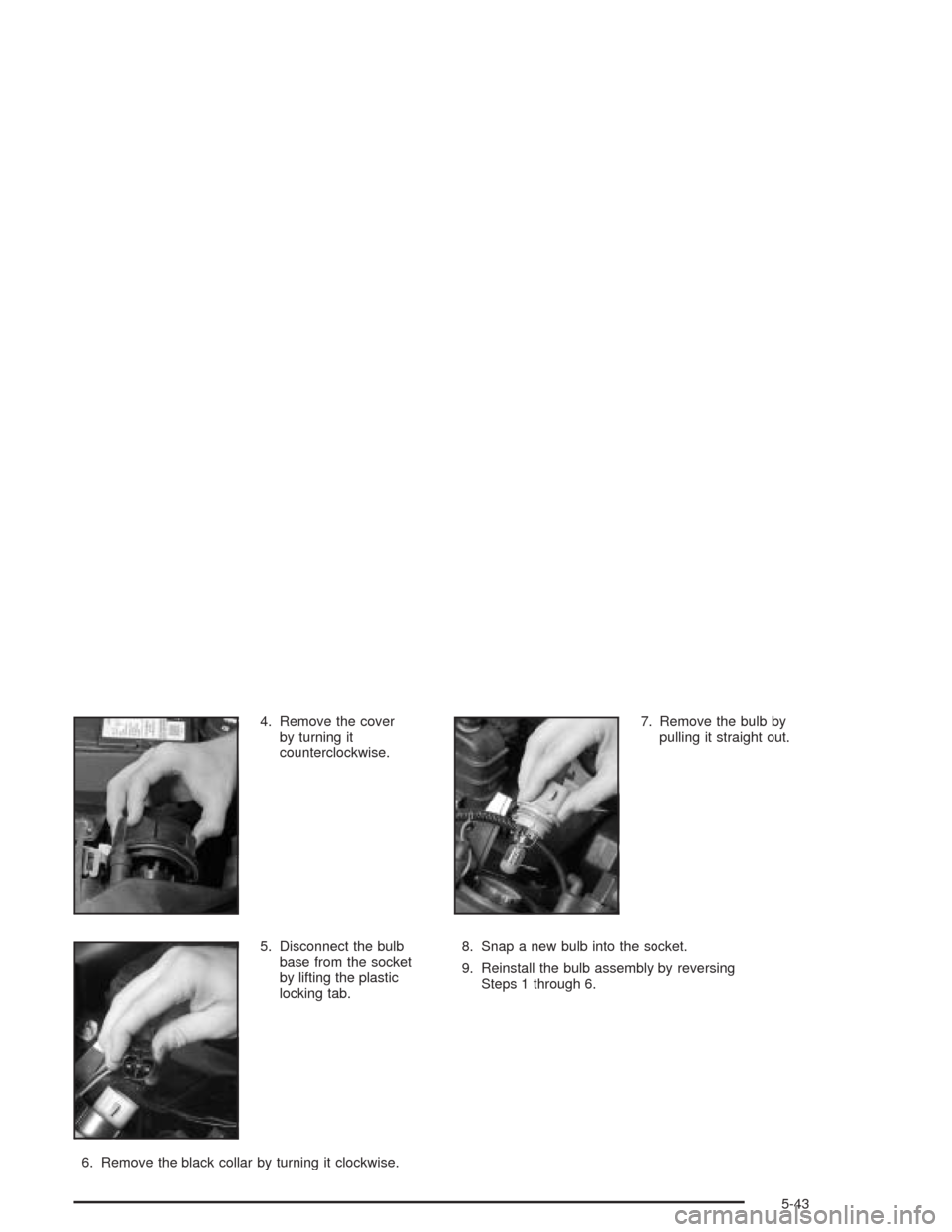
4. Remove the cover
by turning it
counterclockwise.
5. Disconnect the bulb
base from the socket
by lifting the plastic
locking tab.
6. Remove the black collar by turning it clockwise.7. Remove the bulb by
pulling it straight out.
8. Snap a new bulb into the socket.
9. Reinstall the bulb assembly by reversing
Steps 1 through 6.
5-43
Page 258 of 354
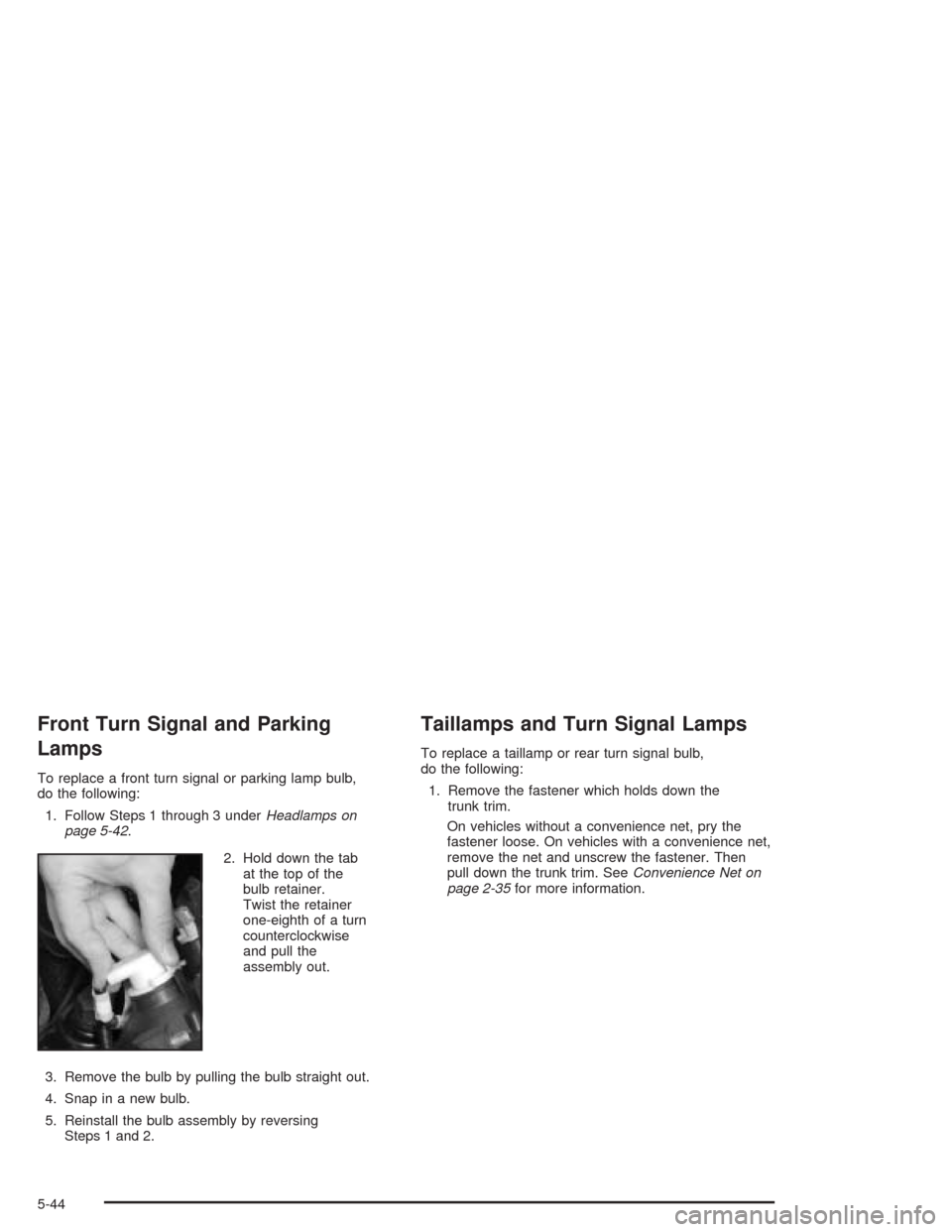
Front Turn Signal and Parking
Lamps
To replace a front turn signal or parking lamp bulb,
do the following:
1. Follow Steps 1 through 3 underHeadlamps on
page 5-42.
2. Hold down the tab
at the top of the
bulb retainer.
Twist the retainer
one-eighth of a turn
counterclockwise
and pull the
assembly out.
3. Remove the bulb by pulling the bulb straight out.
4. Snap in a new bulb.
5. Reinstall the bulb assembly by reversing
Steps 1 and 2.
Taillamps and Turn Signal Lamps
To replace a taillamp or rear turn signal bulb,
do the following:
1. Remove the fastener which holds down the
trunk trim.
On vehicles without a convenience net, pry the
fastener loose. On vehicles with a convenience net,
remove the net and unscrew the fastener. Then
pull down the trunk trim. SeeConvenience Net on
page 2-35for more information.
5-44
Page 259 of 354
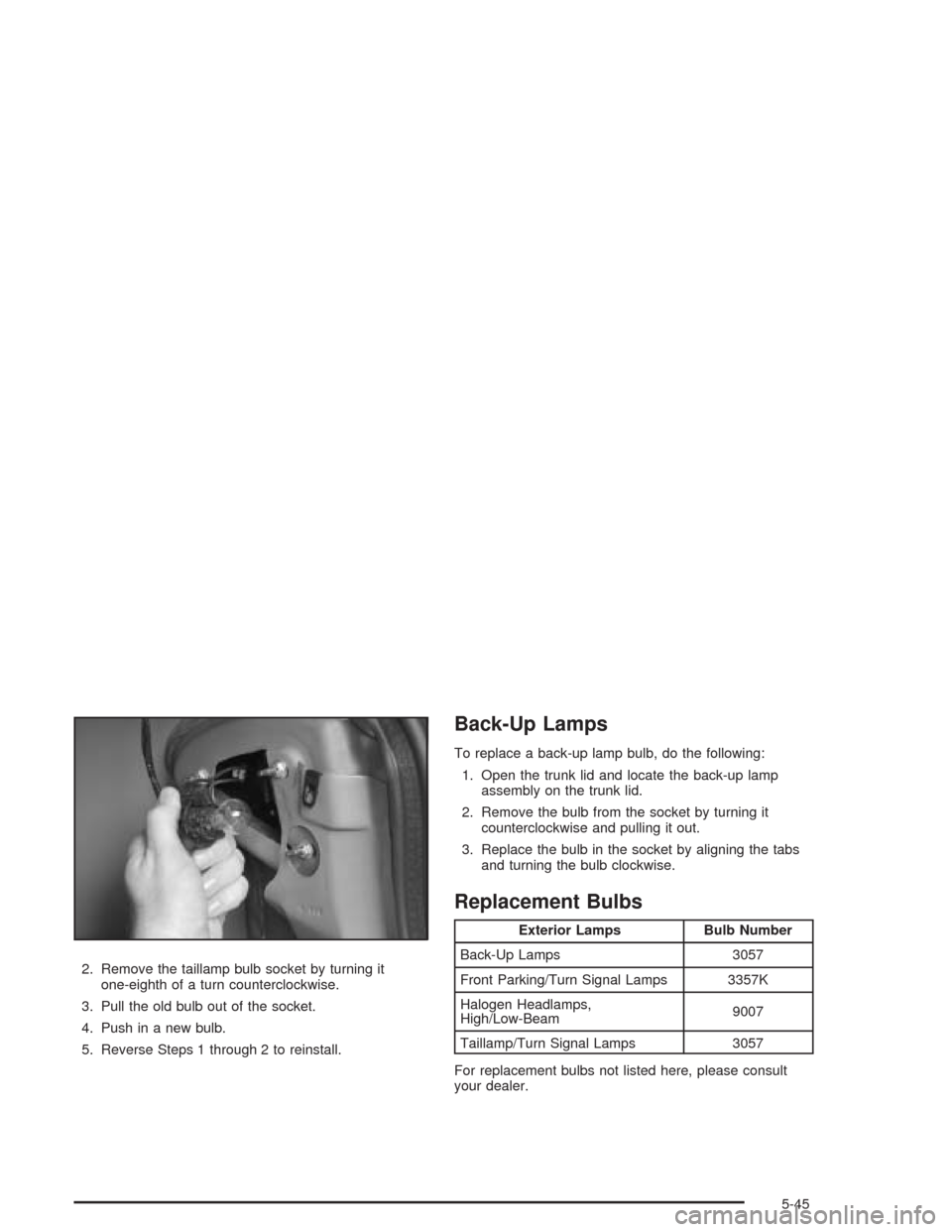
2. Remove the taillamp bulb socket by turning it
one-eighth of a turn counterclockwise.
3. Pull the old bulb out of the socket.
4. Push in a new bulb.
5. Reverse Steps 1 through 2 to reinstall.
Back-Up Lamps
To replace a back-up lamp bulb, do the following:
1. Open the trunk lid and locate the back-up lamp
assembly on the trunk lid.
2. Remove the bulb from the socket by turning it
counterclockwise and pulling it out.
3. Replace the bulb in the socket by aligning the tabs
and turning the bulb clockwise.
Replacement Bulbs
Exterior Lamps Bulb Number
Back-Up Lamps 3057
Front Parking/Turn Signal Lamps 3357K
Halogen Headlamps,
High/Low-Beam9007
Taillamp/Turn Signal Lamps 3057
For replacement bulbs not listed here, please consult
your dealer.
5-45
Page 260 of 354
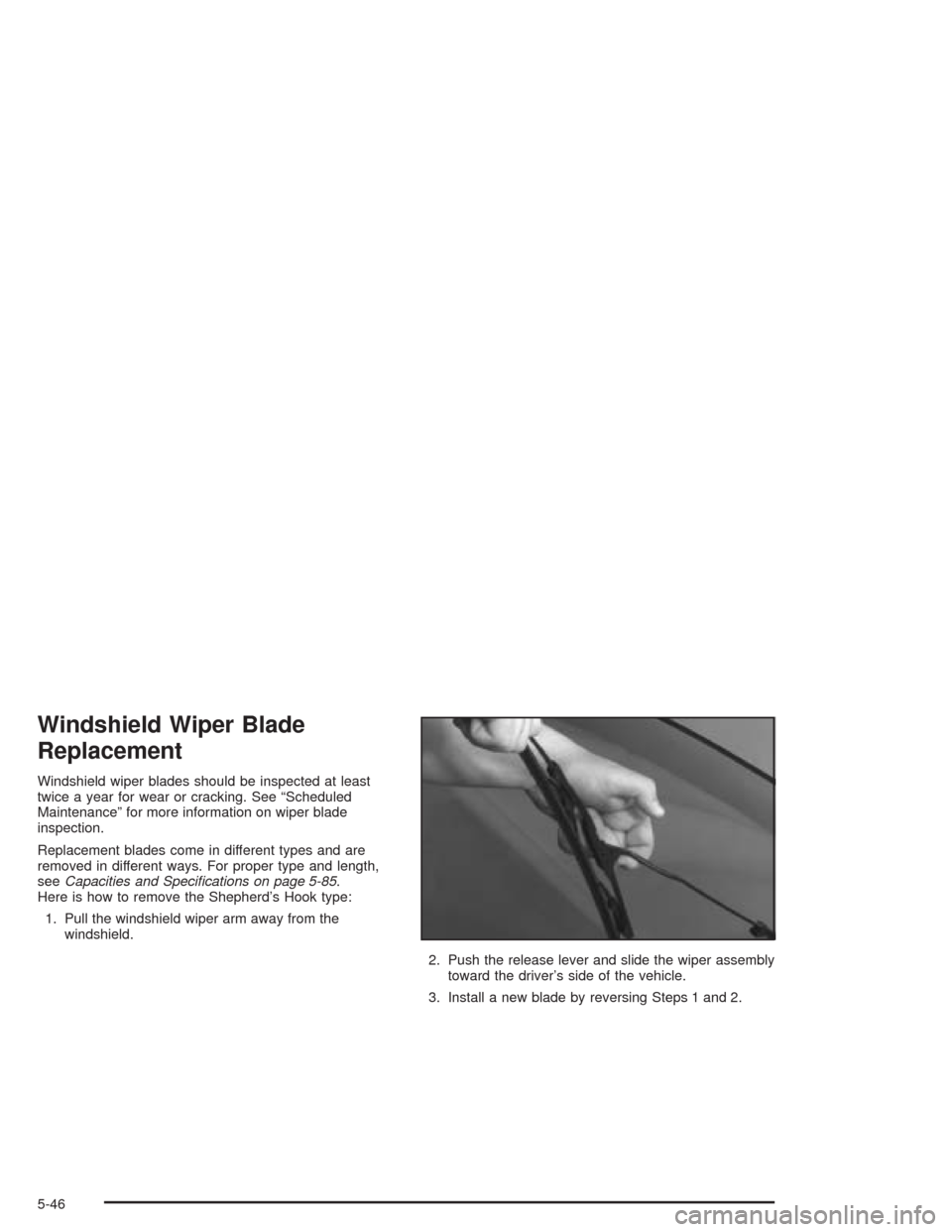
Windshield Wiper Blade
Replacement
Windshield wiper blades should be inspected at least
twice a year for wear or cracking. See “Scheduled
Maintenance” for more information on wiper blade
inspection.
Replacement blades come in different types and are
removed in different ways. For proper type and length,
seeCapacities and Speci�cations on page 5-85.
Here is how to remove the Shepherd’s Hook type:
1. Pull the windshield wiper arm away from the
windshield.
2. Push the release lever and slide the wiper assembly
toward the driver’s side of the vehicle.
3. Install a new blade by reversing Steps 1 and 2.
5-46